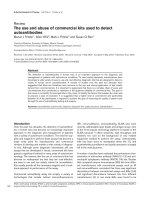Antibiotic-Use-Misuse-and-Abuse
Bạn đang xem bản rút gọn của tài liệu. Xem và tải ngay bản đầy đủ của tài liệu tại đây (627.63 KB, 48 trang )
Antibiotic Use, Misuse, and
Abuse
Brian Levy, MD
Current Antibiotic Trends
• In the United States, we are NOT very good
about treating patients with antibiotics, in both
the inpatient and outpatient settings
• Per the CDC, numerous studies have shown that
30-50% of antibiotics prescribed in hospitals are
unnecessary or inappropriate
• Efforts to improve antibiotics are necessary to
improve patient outcomes while reducing
overall healthcare costs
Problems with Antibiotic Misuse
• Global problem of antibiotic resistance which
is a public health crisis
• Clostridium difficile infections
• Health care costs
• Adverse reactions to antibiotics
• Drug interactions with antibiotics
Antibiotic Resistance
Antibiotic Resistance
• Antibiotic resistance occurs after the
administration of antibiotics where millions of
bacteria may undergo selective pressure and
the bacteria can develop mutations as well as
the acquisition of new genes on plasmids.
• Per the CDC, in the US, there are at least 2
million people infected with antibiotic resistant
bacteria and 23,000 will die as a result.
Antibiotic Resistance
• Even if not fatal, these infections can
significantly have effects on extended hospital
stays and costs.
• Many medical advancements such as joint
replacements, organ transplants, cancer
therapy, and treatment of chronic diseases
such as diabetes, asthma, cystic fibrosis,
bronchiectasis, and rheumatoid arthritis
depend on the ability to fight infections.
Antibiotic Resistance
Antibiotic Introduced
• 1928 PCN
• 1950 tetracycline
• 1953 erythromycin
• 1960 methicillin
• 1972 vancomycin
• 1985 imipenem
• 1996 levofloxacin
• 2000 linezolid
• 2010 ceftaroline
Organism Resistance Identified
•
•
•
•
•
•
•
1940 PCN R-staphylococcus
1959 tetracycline R-shigella
1962 MRSA
1965 PCN R-pneumococcus
1968 erythromcyin R strep
1988 VRE
1996 levofloxacin R
pneumococcus
• 2002 Vanc resistant staph
Antibiotic Resistance
Antibiotic Introduced
Organism Resistance Identified
• 2002 vancomycin R-staph
• 2004 multi drug resistant
acinetobacter and
pseudomonas
• 2009 ceftriaxone RNeisseria
• 2011 ceftaroline R-Staph
Unfortunately Doctors Are Largely to Blame
What Can Doctors and Hospitals Do?
• Is the antibiotic indicated at all?
• Is the appropriate antibiotic being given?
• Is the right amount of time given for the
antibiotic as opposed to a more extensive
duration?
• Is the right dose of the antibiotic being given?
Common Clinical Scenarios
Asymptomatic Bacteruria
• One of the most common abuses of antibiotics
• Asymptomatic bacteruria extremely common in hospital
patients, notably diabetic, elderly women, indwelling
catheterized patients, spinal cord injury patients.
• Screening for and treating asymptomatic bacteruria is
only warranted for 2 sets of patients: pregnancy and
patients undergoing a urologic intervention such as a
TURP or other urologic procedures where mucosal
bleeding anticipated, renal transplant patients in the first
3 months of a transplant
Asymptomatic Bacteruria
• In the absence of specific signs or symptoms (dysuria,
urgency, frequency, suprapubic pain, a fever or
leukocytosis attributed to a UTI), no indication for
screening
• WBC in urine or high colony counts in cultures are not
indications to treat in the absence of symptoms
• Studies have shown that not treating asymptomatic
bacteruria does not reduce frequency of symptomatic
bacteruria and not associated with long term adverse
outcomes or mortality (Scan J Urol Neph. 1998, 32(4):
284)
Asymptomatic Bacteruria
• Antibiotic therapy for asymptomatic UTI’s may even
be harmful per studies
• In a trial women treated for asymptomatic bacteruria
were found to have a higher incidence of a
symptomatic UTI over the next year over women
who did not receive antibiotics (Clin Infect Dis. 2012,
55 (6):771).
• Bacteruria in the absence of symptoms is very
common among catheterized patients and again
does not warrant treatment.
Community Acquired Pneumonia
• Sputum and blood cultures should be obtained to help
guide treatment. However, no pathogen identified in
majority of cases and viral pathogens more common
than bacterial (N Engl J Med. 373: 315, 2015).
• In community acquired infections (not HAP, VAP,
aspiration), most common bacterial organisms or
Strep pneumoniae and atypicals such as
chlamydophilia and mycoplasma).
• Antibiotic recommendations in regards to above:
ceftriaxone plus azithromycin or levofloxacin
Community Acquired Pneumonia
• Duration of treatment: 5-7 days (N Engl J Med,
370:543, 2014)
• Antibiotics can be discontinued safely after 5
days in patients who are afebrile for 48 hours
and have no more than one of following: SBP <
90, HR > 100, RR > 24, O2 sat < 90% (JAMA
Intern Med, 2016 , Sep 1, 176 (9), 1257-65)
• Improved outcome with B-lactam plus macrolide
vs B-lactam alone (Thorax 68:493, 2013)
Community Acquired Pneumonia
• Coverage for MRSA? Not generally indicated as
uncommon, about 2% of cases (Clin Infect Dis 54:1126,
20120
• Exceptions for covering for MRSA in CAP: in IVDU or
influenza associated
• Can use nasal swab PCR for Staph Aureus to exclude
MRSA as the etiology of CAP with a negative predictive
value of 99.2% (Antimicrob Agents Chemother 58:859,
2014).
• Above guidelines refer to hemodynamically stable CAP
Community Acquired Pneumonia
• How about the use of procalcitonin?
• Procalcitonin is a serum biomarker that helps
distinguish bacterial infections from other
sources of infection such as viral or noninfectious etiologies and can also be used to
guide when to stop antibiotics for CAP
• If level < 0.10, bacterial infection thought to be
very unlikely, , 0.10 to 0.25 unlikely, 0.25-.0.50
likely, and >0.50 very likely
Community Acquired Pneumonia
• There is emerging evidence that normalization of
serum procalcitonin level can shorten treatment
duration for CAP. When levels are followed and
trend down, can safely discontinue antibiotics.
(Inf Dis. Clin. No. Amer. 2017, 31:435).
• Procalcitonin is not perfect. False positives: renal
failure, small cell lung CA, severe trauma, cardiac
arrest, surgery, pancreatitis, among others. False
negatives: if drawn too early in course of infection
Cellulitis of the Extremities
• Typically involves rapidly spreading red edematous, tender
plaque-like areas of the skin usually on the lower leg, often febrile.
• A study showed that in patients with extremity cellulitis that was
non-purulent, the etiology was almost always identified as beta
hemolytic streptococcus (Group A, C, or G). (Infect Dis, 3: Nov 25,
2015).
• The indications to treat for MRSA would be is there is a purulent
discharge, an abscess suspected, or in setting of IVDU. Otherwise
the treatment should be guided towards strep with antibiotics
such as PCN or cefazolin (Vancomycin only if history of PCN
anaphylactic reaction). No need for other broader coverage.
Cellulitis of the Extremites
• Usual duration of therapy is 7-10 days.
• Stasis dermatitis due to venous insufficiency
often mimics cellulitis. It is typically bilateral,
chronic, and patient is afebrile (Ann Intern
Med, 142:47, 2005). There is no benefit from
giving antibiotics. (JAMA 311: 2534, 2014).
What are Hospitals Doing to Stop Combat the
Antibiotic Issues?
Antimicrobial Stewardship
• Numerous professional societies and government
agencies have issued new guidelines and requirements
to address the issues of antibiotic abuse and misuse.
• Antibiotic stewardship refers to the systematic
measurement and coordinated interventions designed
in hospitals to promote optimal use of antibiotics.
• The primary goal of antimicrobial stewardships is to
optimize clinical outcomes while minimizing
unintended consequences of antibiotics and the
emergence of resistant organisms.
Antimicrobial Stewardship
• Who is part of the antimicrobial stewardship committee in
hospitals? Typically pharmacists with experience in
antimicrobials and with physician guidance, often an infectious
disease physician
• There are a number of specific interventions that the members
of the antimicrobial stewardship do in the hospital.
• Antibiotic “time outs”. A review is done at 48 hours. The
following questions are asked: Does this patient have an
infection responding to antibiotics? If so is the patient on the
right antibiotic based on culture results and suspected source of
infection? If so, can the antibiotic selection be narrowed? How
long should the patient receive antibiotics?
Antimicrobial Stewardship
• Prior authorization. Some hospitals restrict the use of
certain antibiotics based on cost, broad spectrum of
activity, or toxicities. Some require an ID consult to
continue using.
• Automatic changes from IV to oral antibiotics when
appropriate.
• Dose adjustments in cases of organ dysfunction (i.e.
renal failure).
• Alerts in situations when it is felt an inappropriate
antibiotic is being used.









